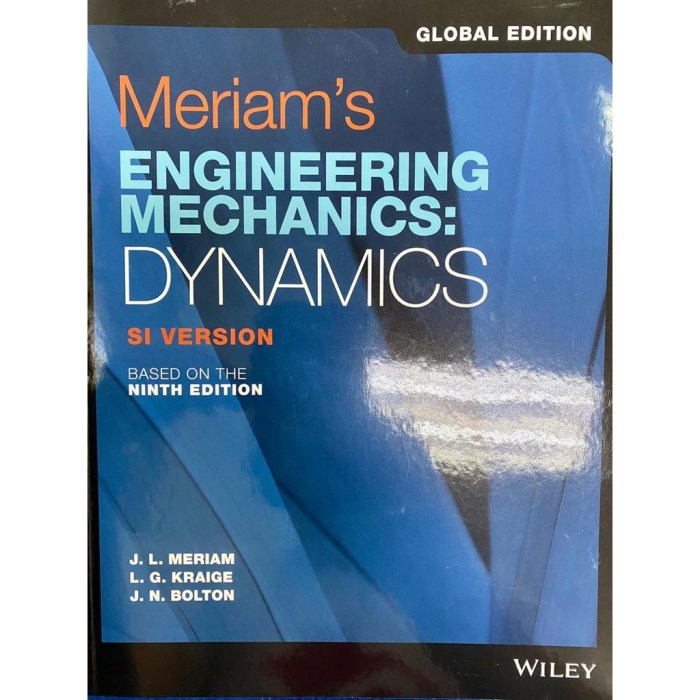Engineering Mechanics Dynamics 15th Edition embarks on a captivating journey into the realm of motion, revealing the fundamental principles that govern the behavior of objects in motion. This seminal work provides a comprehensive exploration of the subject, offering a profound understanding of the intricate forces that shape our physical world.
Delving into the depths of Newton’s laws of motion, kinematics, kinetics, and energy methods, Engineering Mechanics Dynamics 15th Edition unravels the secrets of motion, empowering readers to analyze and predict the behavior of dynamic systems with precision and accuracy.
1. Engineering Mechanics Dynamics 15th Edition Introduction

The 15th edition of Engineering Mechanics Dynamics represents a significant advancement in the field of engineering mechanics. This comprehensive textbook provides an updated and in-depth coverage of the fundamental principles and applications of dynamics, catering to the evolving needs of students and professionals alike.
The book is meticulously structured into chapters, each focusing on a specific aspect of dynamics. The chapters are logically organized, building upon the concepts introduced in previous chapters. This allows readers to progressively develop a deep understanding of the subject matter.
The 15th edition is intended for undergraduate students majoring in engineering, particularly those pursuing degrees in mechanical, civil, and aerospace engineering. It assumes a basic understanding of statics, calculus, and differential equations.
2. Key Concepts and Principles
Engineering Mechanics Dynamics encompasses a wide range of fundamental concepts and principles that govern the motion of objects and systems. The book covers these concepts in great detail, providing a solid foundation for understanding the behavior of dynamic systems.
One of the central themes of the book is Newton’s laws of motion. These laws provide the mathematical framework for analyzing the motion of objects under the influence of external forces. The book thoroughly explores the applications of Newton’s laws in various scenarios, including particle dynamics, rigid body dynamics, and system dynamics.
Other key concepts covered in the book include kinematics, kinetics, and energy methods. Kinematics focuses on describing the motion of objects without considering the forces acting on them. Kinetics, on the other hand, deals with the relationship between forces and the motion of objects.
Energy methods provide a powerful tool for analyzing dynamic systems by considering the conservation of energy.
3. Problem-Solving Techniques: Engineering Mechanics Dynamics 15th Edition
Engineering Mechanics Dynamics places great emphasis on problem-solving skills. The book presents a systematic approach to problem-solving, guiding readers through the steps involved in analyzing and solving dynamics problems.
The book introduces various problem-solving methods and techniques, including the use of free-body diagrams, equations of motion, and energy equations. Free-body diagrams help visualize the forces acting on an object, while equations of motion provide the mathematical equations that govern the object’s motion.
Energy equations can be used to solve problems involving energy conservation.
The book provides numerous worked examples and practice problems to help readers develop their problem-solving skills. These problems cover a wide range of topics, allowing readers to practice applying the concepts and principles learned in the book.
4. Applications in Engineering

Engineering Mechanics Dynamics has far-reaching applications in various engineering fields. The book provides real-world examples to illustrate how the principles of dynamics are applied in practice.
Examples from structural engineering demonstrate how the concepts of dynamics are used to design and analyze structures that can withstand external forces such as earthquakes and wind loads. Mechanical engineering applications include the analysis of machine components, such as gears and shafts, to ensure they operate smoothly and efficiently.
In aerospace engineering, the principles of dynamics are used to design and control aircraft, spacecraft, and other aerospace vehicles. The book discusses the challenges of designing systems that can withstand the extreme forces encountered during flight.
Common Queries
What are the key concepts covered in Engineering Mechanics Dynamics 15th Edition?
Engineering Mechanics Dynamics 15th Edition delves into fundamental concepts such as Newton’s laws of motion, kinematics, kinetics, energy methods, and advanced topics like vibrations, stability, and chaos.
How does Engineering Mechanics Dynamics 15th Edition enhance problem-solving skills?
The book adopts a systematic problem-solving approach, utilizing free-body diagrams, equations of motion, and energy equations to guide readers through the analysis of dynamic systems.
What are the pedagogical features that make Engineering Mechanics Dynamics 15th Edition an effective learning tool?
Engineering Mechanics Dynamics 15th Edition incorporates worked examples, practice problems, review questions, interactive simulations, and online resources to enhance comprehension and retention.